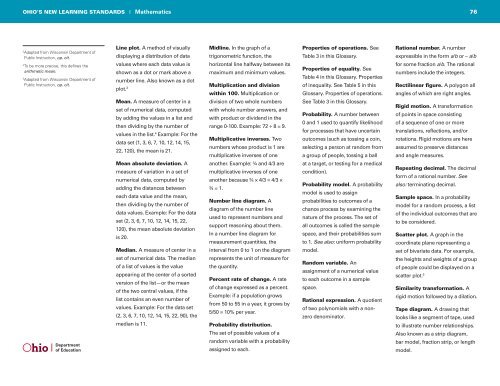Math-Standards.pdf
Math-Standards.pdf
Math-Standards.pdf
You also want an ePaper? Increase the reach of your titles
YUMPU automatically turns print PDFs into web optimized ePapers that Google loves.
OHIO’S NEW LEARNING STANDARDS I <strong>Math</strong>ematics 76<br />
3<br />
Adapted from Wisconsin Department of<br />
Public Instruction, op. cit.<br />
4<br />
To be more precise, this defines the<br />
arithmetic mean.<br />
5<br />
Adapted from Wisconsin Department of<br />
Public Instruction, op. cit.<br />
Line plot. A method of visually<br />
displaying a distribution of data<br />
values where each data value is<br />
shown as a dot or mark above a<br />
number line. Also known as a dot<br />
plot. 3<br />
Mean. A measure of center in a<br />
set of numerical data, computed<br />
by adding the values in a list and<br />
then dividing by the number of<br />
values in the list. 4 Example: For the<br />
data set {1, 3, 6, 7, 10, 12, 14, 15,<br />
22, 120}, the mean is 21.<br />
Mean absolute deviation. A<br />
measure of variation in a set of<br />
numerical data, computed by<br />
adding the distances between<br />
each data value and the mean,<br />
then dividing by the number of<br />
data values. Example: For the data<br />
set {2, 3, 6, 7, 10, 12, 14, 15, 22,<br />
120}, the mean absolute deviation<br />
is 20.<br />
Median. A measure of center in a<br />
set of numerical data. The median<br />
of a list of values is the value<br />
appearing at the center of a sorted<br />
version of the list—or the mean<br />
of the two central values, if the<br />
list contains an even number of<br />
values. Example: For the data set<br />
{2, 3, 6, 7, 10, 12, 14, 15, 22, 90}, the<br />
median is 11.<br />
Midline. In the graph of a<br />
trigonometric function, the<br />
horizontal line halfway between its<br />
maximum and minimum values.<br />
Multiplication and division<br />
within 100. Multiplication or<br />
division of two whole numbers<br />
with whole number answers, and<br />
with product or dividend in the<br />
range 0-100. Example: 72 ÷ 8 = 9.<br />
Multiplicative inverses. Two<br />
numbers whose product is 1 are<br />
multiplicative inverses of one<br />
another. Example: ¾ and 4/3 are<br />
multiplicative inverses of one<br />
another because ¾ × 4/3 = 4/3 ×<br />
¾ = 1.<br />
Number line diagram. A<br />
diagram of the number line<br />
used to represent numbers and<br />
support reasoning about them.<br />
In a number line diagram for<br />
measurement quantities, the<br />
interval from 0 to 1 on the diagram<br />
represents the unit of measure for<br />
the quantity.<br />
Percent rate of change. A rate<br />
of change expressed as a percent.<br />
Example: if a population grows<br />
from 50 to 55 in a year, it grows by<br />
5/50 = 10% per year.<br />
Probability distribution.<br />
The set of possible values of a<br />
random variable with a probability<br />
assigned to each.<br />
Properties of operations. See<br />
Table 3 in this Glossary.<br />
Properties of equality. See<br />
Table 4 in this Glossary. Properties<br />
of inequality. See Table 5 in this<br />
Glossary. Properties of operations.<br />
See Table 3 in this Glossary.<br />
Probability. A number between<br />
0 and 1 used to quantify likelihood<br />
for processes that have uncertain<br />
outcomes (such as tossing a coin,<br />
selecting a person at random from<br />
a group of people, tossing a ball<br />
at a target, or testing for a medical<br />
condition).<br />
Probability model. A probability<br />
model is used to assign<br />
probabilities to outcomes of a<br />
chance process by examining the<br />
nature of the process. The set of<br />
all outcomes is called the sample<br />
space, and their probabilities sum<br />
to 1. See also: uniform probability<br />
model.<br />
Random variable. An<br />
assignment of a numerical value<br />
to each outcome in a sample<br />
space.<br />
Rational expression. A quotient<br />
of two polynomials with a nonzero<br />
denominator.<br />
Rational number. A number<br />
expressible in the form a/b or – a/b<br />
for some fraction a/b. The rational<br />
numbers include the integers.<br />
Rectilinear figure. A polygon all<br />
angles of which are right angles.<br />
Rigid motion. A transformation<br />
of points in space consisting<br />
of a sequence of one or more<br />
translations, reflections, and/or<br />
rotations. Rigid motions are here<br />
assumed to preserve distances<br />
and angle measures.<br />
Repeating decimal. The decimal<br />
form of a rational number. See<br />
also: terminating decimal.<br />
Sample space. In a probability<br />
model for a random process, a list<br />
of the individual outcomes that are<br />
to be considered.<br />
Scatter plot. A graph in the<br />
coordinate plane representing a<br />
set of bivariate data. For example,<br />
the heights and weights of a group<br />
of people could be displayed on a<br />
scatter plot. 5<br />
Similarity transformation. A<br />
rigid motion followed by a dilation.<br />
Tape diagram. A drawing that<br />
looks like a segment of tape, used<br />
to illustrate number relationships.<br />
Also known as a strip diagram,<br />
bar model, fraction strip, or length<br />
model.


